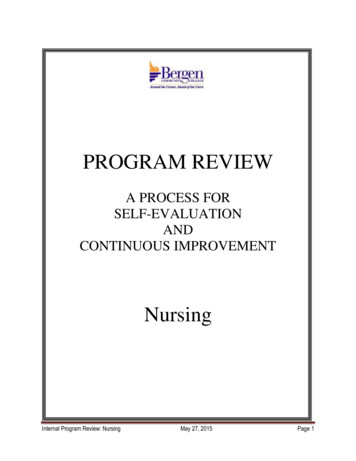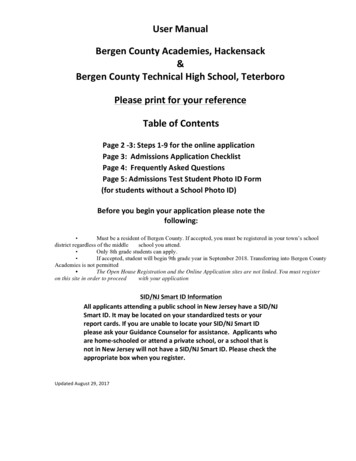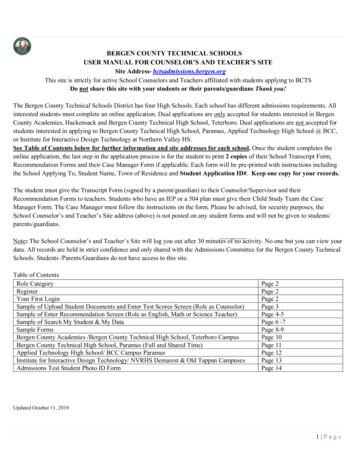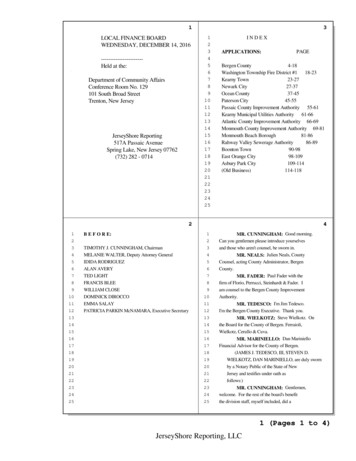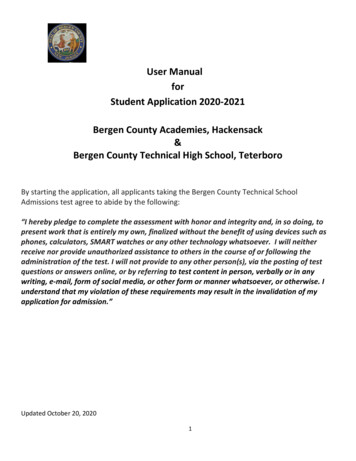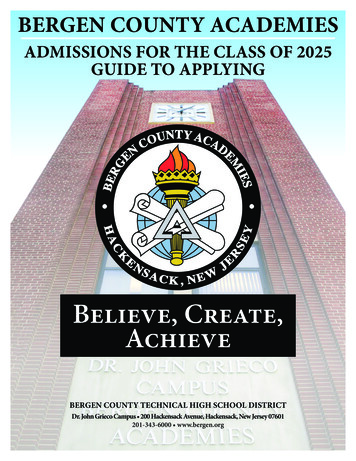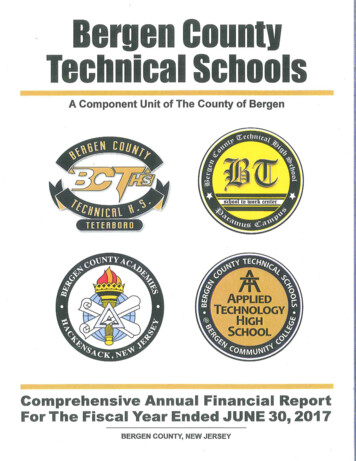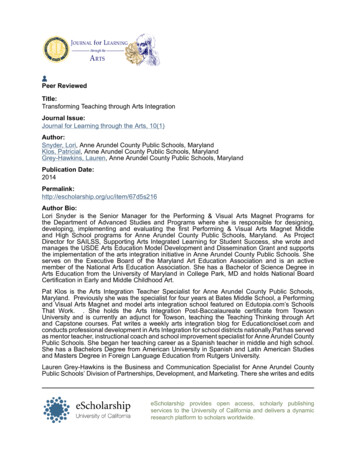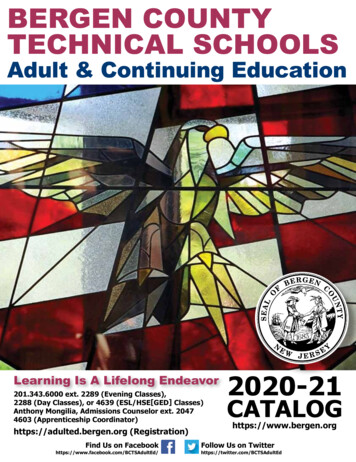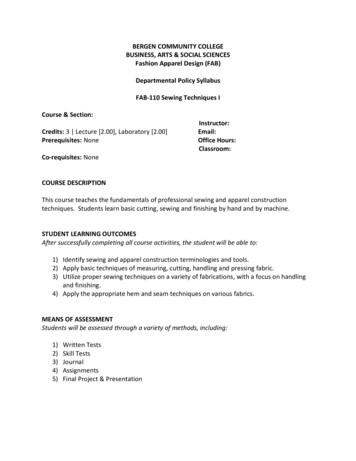
Transcription
BERGEN COMMUNITY COLLEGEBUSINESS, ARTS & SOCIAL SCIENCESFashion Apparel Design (FAB)Departmental Policy SyllabusFAB-110 Sewing Techniques ICourse & Section:Credits: 3 Lecture [2.00], Laboratory [2.00]Prerequisites: NoneInstructor:Email:Office Hours:Classroom:Co-requisites: NoneCOURSE DESCRIPTIONThis course teaches the fundamentals of professional sewing and apparel constructiontechniques. Students learn basic cutting, sewing and finishing by hand and by machine.STUDENT LEARNING OUTCOMESAfter successfully completing all course activities, the student will be able to:1) Identify sewing and apparel construction terminologies and tools.2) Apply basic techniques of measuring, cutting, handling and pressing fabric.3) Utilize proper sewing techniques on a variety of fabrications, with a focus on handlingand finishing.4) Apply the appropriate hem and seam techniques on various fabrics.MEANS OF ASSESSMENTStudents will be assessed through a variety of methods, including:1)2)3)4)5)Written TestsSkill TestsJournalAssignmentsFinal Project & Presentation
REQUIRED TEXTBOOK & RESOURCESReader’s Digest, New Complete Guide To Sewing: Step-By-Step Techniques For MakingClothes And Home Accessories, 2010, ISBN(10/13): 1606522086 / 9781606522080STUDENT SUPPLIESSewing machine footBobbinsThreadScissors (paper and fabric)Hand sewing needlesSeam ripperMeasuring tapeTailors chalkThe school will supply various fabric swatches for class assignments.SUGGESTED RESOURCESAmaden-Crawford, Connie; A Guide to Fashion Sewing, 5 Ed, Fairchild, 2010.ISBN-13: ing CenterThe tutoring center is located in L-125. Telephone: (201) 447-7489 and online at:http://www.bergen.edu/tutoring/Writing CenterAvailable in person room L-125 and online: ryThe library has a number of textbooks, databases, multimedia and aids in its regular andreserve holdings, which may be used as a reference. In addition to the resources mentionedabove students should be encouraged to make full use of the Sidney Silverman Library (inperson and online at http://www.bergen.edu/library/.
RESEARCH, WRITING & EXAMINATION REQUIREMENTSTestsStudents will be tested on the information (ie, basic sewing terms) and skills (ie. hemming,finishing) learned in each unit of study.AssignmentsStudents will be given assignments related to each unit of study. (ie. Sewing Practicums:cutting, hemming and stitching)JournalStudents will keep a personal journal that categorizes their design ideas and inspiration.Final Project & PresentationStudents will construct a simple sleeveless sundress from a choice of basic sturdy fabricationssuch as cotton twill, linen etc. Students must choose from a supplied choice of basic sleevelessdress patterns, as well as a variety of fabrications and make the dress choosing the appropriateseam types, finishes and hems.COURSE CONTENTThis course will cover the following units of study:UNIT 1: Students will learn basic cut and sew techniques, with a focus on using an industrialsewing machine.UNIT 2: Students will learn basting, seaming, and finishing on a variety of fabrics.UNIT 3: Students will learn hemming and closure techniques on a variety of fabrics.UNIT 4: Students will learn to construct and finish simple necklines and armholes, and use thecorrect choice of interlinings for the fabric.UNIT 5: Students will learn simple decorative techniques including pin tucks, gatherings andpleats.GRADING POLICYTests 20%Assignments 30%Journal 20%Final Project & Presentation 30%
GRADING SCALE90-100%86-89%80-85%76-79%AB BC 70-75%60-69%0-59%CDFBCC ATTENDANCE POLICYAll students are expected to attend punctually every scheduled meeting of each course in whichthey are registered. Attendance and lateness policies and sanctions are to be determined bythe instructor for each section of each course. These will be established in writing on theindividual course outline. Attendance will be kept by the instructor for administrative andcounseling purposes.FAB ATTENDANCE POLICYClass participation and in-class work are key to succeeding in fashion apparel design. Three ormore absences will result in a full letter grade drop for this course. Six or more absences willresult in an automatic failing grade.COURSE OUTLINEWeek 1:Overview curriculum, review rules and regulations, projects and safety.Class Introduction. Introduction to domestic and industrial machinery. Threading and straightstitching. Review fabric types and qualities and introduce the first project.Week 2:Demo, review and practice basic marking and cutting on a variety of fabrics. Explain and identifystraight of grain, cross grain, bias etc., as well as review ripping fabric, squaring fabric, andappropriate pressing of various fabric types etc.Week 3:Review, demo and practice basic seams, darts and panels on a variety of stable fabrics such ascotton, linen, etc. SeamsWeek 4:Test: Fabric handling, machine threading, and basic seaming.
Demo, review and practice different seam types, such as run and fell, top-stitched, double topstitched, French seams, as well as stretch seams.Week 5:Demo, review and practice seams above on a variety of difficult fabrics (ie. charmeuse, chiffon,georgette, organza, denim, gauze etc.)Week 6:Demo, review and practice different internal finishes including serging, zig-zag, single turn,double turn etc.Week 7:Learn about the various types of garment closures, including buttons/buttonholes, invisible ®ular zipper insertion, hooks and eyes, snaps etc.Week 8:Demo, review and practice various hand stitches and finishing, including basting, handhemming, tailors tacks, attaching hooks and eyes, snaps etc.Test: SeamingWeek 9:Demo, review and practice different hem types, including bound, faced, turn turn, single turnetc., on a variety of fabrics from basic to difficult.Week 10:Test: HemmingDemo, review and practice simple necklines, including faced neckline, bound neckline,Mandarin collar etc., along with appropriate interlining choices.Week 11:Demo, review and practice simple faced and bound armholes, and the appropriate use ofinterlining, including fusible, weight and placement options).Week 12:Demo, review and practice various decorative techniques and methods to control fullnessincluding gathering, pleating, and pin tucks. Discuss final project.Week 13:Work on final project.Week 14:Work on final project.Week 15:
Complete Final Project. Presentation.Note to Students: This Course Outline and Calendar is tentative and subject to change,depending upon the progress of the class.
2) Apply basic techniques of measuring, cutting, handling and pressing fabric. 3) Utilize proper sewing techniques on a variety of fabrications, with a focus on handling and finishing. 4) Apply the appropriate hem and seam techniques on various fabrics. MEANS OF ASSESSMENT Students
